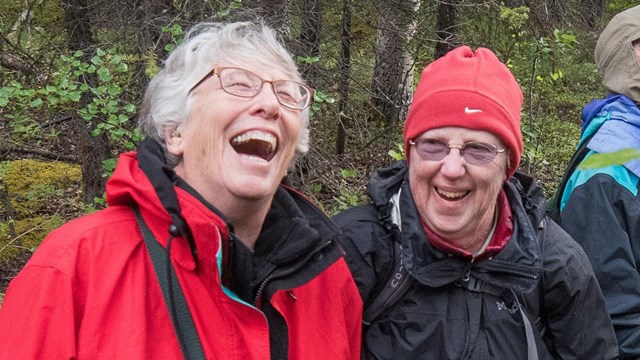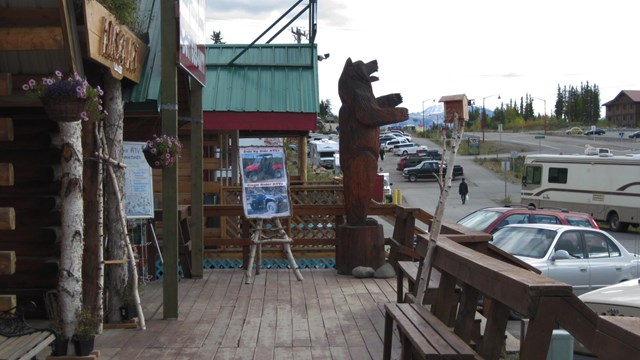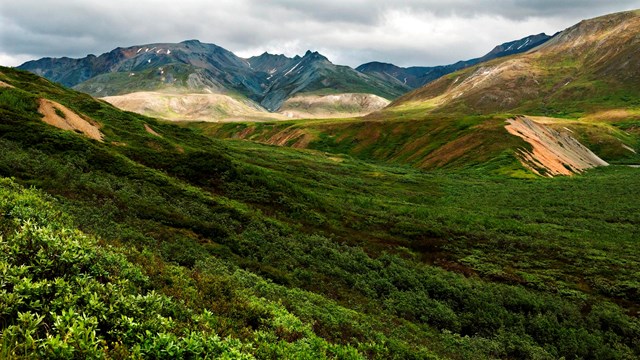
NPS Photo / Kent Miller
Visitors to Denali are unique—traveling great distances to come to this special park. To understand the park's visitors, social scientists research how individuals enjoy Denali. They do this by asking questions such as:
Explore the sections below to learn more about social science in Denali.

Visitor Trends
Who visits Denali every year and why? Learn more about what the average visitor to Denali is like. 
The Local Economy
Discover how buying your bus ticket into the park affects the local economy as a result of visiting the park. 
Wilderness
Two million acres of designated wilderness preserve wilderness character, cultural resources, and a vast, intact ecosystem. Visitor Experience and Park Management
Upcoming and Ongoing ResearchMultiple social science studies take place in Denali National Park and Preserve every year. Below explore current and upcoming projects.The Denali Backcountry Management Plan stipulates a largescale visitor survey be conducted every 5 years. The survey is designed to understand the visitor wilderness experience by examining resource and social conditions.
Resource conditions are examined by the indicators of: trail and campsite disturbance, evidence of modern human use, landscape modifications, litter and human waste, and natural sound disturbance. Social conditions are examined by the indicators of: encounters with people, encounters with large groups, camping density, accessibility, and administrative presence. The most recent survey was carried out in 2017. 431 backpackers and 120 day hikers were contacted. Similar to survey results acquired in 2010, the resource indicator of natural sound disturbance was out of standard for most backcountry units visited by backpackers and day hikers. Other resource and social indicators were typically within standard. Some key statistics identified this year include: - The majority of backpackers hiked less than 8 hours and averaged a hike distance of 4.6 miles/day - 78% of visitors spend time on informal trails while only 63% of visitors spend time on formal trails - Over 1/4 of backpackers are professionals in the medical or engineering & technology fields - Most frequently cited motivations for hiking in the park: 1. Experience solitude and nature; 2. View wildlife; 3. Have an adventure - 58% of backpackers, and 22% of day hikers, came to Denali because they wanted to hike in trail-less wilderness - 59% of visitors surveyed were highly prepared for bear encounters, while 25% were ill-prepared The results of this and future surveys are used to assess the state of natural resources and visitor experience in Denali's backcountry. Findings are used to inform future management decisions. Ongoing studies focus on understanding how many people come to visit Denali National Park, what activities they engage in, and how frequently different areas of the park are visited. This information is collected using automatic counters inside the visitor center and along some trails, and by compiling visitor center, guided hiking, and shuttle bus passenger logs.
Interesting findings from the 2017 count include: - Polychrome Overlook trail had the highest use of any trail measured (about 1,900 people/day). However, the vast majority of visitors spent less than 10 minutes in the area - The most popular hiking trail over 1/4 mile is Horseshoe Lake - Visitation rose to 642,118 visits in 2017, a 8.4% increased from 2016 and a 12.6% increase from 2015 - 4,163 visitors were issued backcountry permits in 2017, a 5.3% increase from 2015 Visitation patterns are continually monitored to determine where use is concentrated in the park and to inform management decisions. This project builds on preliminary research conducted from 2015 – 2017. Ongoing study aims to understand the values of local communities and engage with residents to strengthen social, ecological, and economic well-being.
Through the collection of qualitative (interviews, discussion groups) and quantitative (participatory mapping and survey) data over a four-year period, researchers will build strategies for how public land management agencies can focus policy in response to community needs and preferences. In 2017, the park launched a study to understand how visitors to the park's Savage River rest area interacted with wildlife safety messaging. Two types of messaging were considered: a wildlife safety pledge delivered by a posted intern and the park's signage concerning wildlife safety.
In total, 389 visitors were observed. Of these visitors: - Only 4% of visitors were seen reading any wildlife safety signs - 5% of visitors read other signs at the site, but not the wildlife safety signs - However, 7% of the non-sign readers did notice the "bears frequent this area" sign at the trailhead and asked other members in their party if they had bear spray - Visitors who received wildlife safety information by the intern were more likely to read wildlife signage This research gives insight on how to best educate visitors on wildlife safety in the park. Researchers with the Leave No Trace Center for Outdoor Ethics and Pennsylvania State University collaborated with NPS staff to collect data at three pilot Zero Landfill Initiatve (ZLI) parks: Denali, Yosemite, and Grand Teton National Park.
Their study explored visitor attitudes, values, and behaviors towards waste in national parks. As a result of ZLI, diversion has increased from 18 to 23% in Denali National Park. Other key findings include: - Approximately 66% of respondents brought items into the park that they later disposed of within the park - Over half of the sample reported disposing of recyclable material in a recycling container in the park - Nearly three fourths of visitors properly disposed of their waste and recycling - Plastic wrappers were the most frequently discarded item, with over one third of visitors disposing of a non-recyclable plastic wrapper - Analysis suggests that only perceived difficulty (actively sorting waste, minimizing amount of waste generated in the park, etc.), moral norms (sense of responsibility, feelings of guilt, etc.), and ZLI awareness had a significant influence on visitor behavioral intention The findings from this study provide guidance for NPS staff regarding which strategies may be effective in reaching zero-waste management objectives. This study aimed to better understand how visitors feel about noise heard around the park’s entrance. With more and more visitors to Denali every year, anthropogenic (human-made) noise events occur with increasing frequency and duration. Two aspects of research were used.
The first aspect consisted of an experience survey. The survey asked visitors to relate their experiences and preferences of sounds, and then had visitors listen to sound clips with headphones and share their feelings towards the sounds. The second aspect was soundscape monitoring. Listening stations were moved around the front country to create an acoustics map. Interesting findings included: - Aircraft noise was perceived as acceptable, but annoying. However, an average of 39-55 events/day (depending on sample site) would prevent a visitor from returning to visit Denali - Wind and water sounds were especially hard to differentiate, while hearing birdsong was rare. Visitors tended to be much more attuned to anthropogenic sounds, such as other voices, walking, and traffic - The longer a visitor had spent in the park, the higher acoustic acuity rating the visitor achieved with natural sounds. The longer we are away from persistent anthropogenic sounds, the more we can perceive the backdrop of natural sounds This study helped define noise boundaries required to give visitors the most positive experience in the park. Researchers from the University of Illinois at Urbana-Champaign collaborated with the Denali National Park social scientist to evaluate the values, behaviors, and on-ground travel patterns of visitors to the park in 2016.
Values, defined as guiding principles in life, shaped environmentally beneficial behavior. Most visitors reported strong Altruistic and Biospheric values indicating they were most concerned about the well-being of other people and non-human species. Hedonic values centered on interests in short-term gratification (e.g., leisure) were also important, while Egoistic values (i.e., self-centered concerns) were the least important guiding principles in life. Central findings include: - Biospheric and Egoistic values strongly encouraged environmental behavior, while Hedonic values negatively influenced it - Cultural values (i.e., guiding worldviews that define societies), were important predictors of individual values and, in turn, behavior. The predominant worldview of Denali visitors was individualist and egalitarian - Front country visitors associated values with a broader array of places in the park, whereas backcountry users valued fewer places more intensely - Respondents spent an average of two days in the backcountry and traveled about six miles - There was an equal number of males and females surveyed. The average age was 44 years and respondents were well educated. Nearly half earned greater than $100,000 annually Knowledge of the relationship between values and behaviors is essential for informed and effective decision-making. A greater understanding of cultural, individual, and assigned values helps close the so-called “value-action” gap and provides insights into the decisions and judgements of park visitors. Abundant Cretaceous-age fossil plants and vertebrate footprints, including dinosaurs, are being documented and studied from newly discovered localities in Denali National Park. As these findings become more public, research is needed to anticipate and plan for potential visitor use challenges.
This project will undertake onsite social science research in the park. Specifically, the purpose of this research is to better understand park visitors’ attitudes, awareness, opinions, relationship, and experience with paleontological resources in Denali. This project builds on a 2016 report on the economic value of wolves in Denali National Park. Through administering a survey, researchers hope to better understand how trapping of wolves is felt and perceived by active Denali-region subsistence and hobby trappers.
This information will be used, together with other hunter and Alaska household surveys, to determine the consumptive and non-consumptive economic value of wolves in Denali. Managers tasked with making decisions regarding wildlife management need accurate information on the economic values of wolves to viewers, hunters, trappers and the general public to make well informed decisions regarding management of wolves and their prey. **For more information on these projects or to explore collaboration possibilities please contact Dave Schirokauer, Denali's team leader for science and resources Social Science Stories |
Last updated: February 28, 2024
